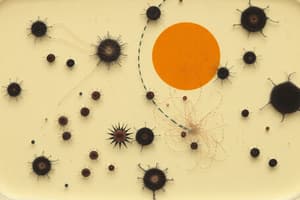Podcast
Questions and Answers
Describe what a pure culture is.
Describe what a pure culture is.
A pure culture contains only a single kind of organism.
What is a mixed culture compared to a pure culture?
What is a mixed culture compared to a pure culture?
A mixed culture contains more than one kind of organism, and a pure culture contains only a single kind of organism.
What is a contaminated culture?
What is a contaminated culture?
It contains a desired organism (pure culture) but an unwanted one.
What is the benefit of a pure culture?
What is the benefit of a pure culture?
What are some methods for obtaining pure cultures?
What are some methods for obtaining pure cultures?
What procedures involve diluting bacterial cells in a sample for isolated colonies?
What procedures involve diluting bacterial cells in a sample for isolated colonies?
What is the method most commonly used by microbiologists to obtain pure cultures? Why?
What is the method most commonly used by microbiologists to obtain pure cultures? Why?
How to perform the streak method?
How to perform the streak method?
How can we evaluate whether a culture is pure?
How can we evaluate whether a culture is pure?
Determine purity of bacteria that was streaked.
Determine purity of bacteria that was streaked.
Determine the term 'colony' as it relates to bacterial growth on solid media.
Determine the term 'colony' as it relates to bacterial growth on solid media.
Why is dilution a necessary part of pure culture preparation?
Why is dilution a necessary part of pure culture preparation?
What advantages does the streak plate method have over the pour plate method?
What advantages does the streak plate method have over the pour plate method?
What colony characteristics can be used for differentiation of bacterial species?
What colony characteristics can be used for differentiation of bacterial species?
What advantage does the pour plate method have over the streak plate method?
What advantage does the pour plate method have over the streak plate method?
Why is the loop flamed before it is placed in the culture tube?
Why is the loop flamed before it is placed in the culture tube?
Explain why plates should be inverted during incubation.
Explain why plates should be inverted during incubation.
Describe the difference between the appearance of surface and subsurface colonies in a pour plate.
Describe the difference between the appearance of surface and subsurface colonies in a pour plate.
If this is the same bacterial species, why do these differences in colonial growth occur?
If this is the same bacterial species, why do these differences in colonial growth occur?
Flashcards are hidden until you start studying
Study Notes
Pure Cultures and Mixed Cultures
- A pure culture contains only one type of organism, essential for studying specific characteristics.
- A mixed culture consists of multiple organisms, complicating analysis and identification.
- Contaminated cultures contain a desired organism along with unwanted ones.
Benefits and Methods of Pure Cultures
- Pure cultures allow for detailed study of an organism's cultural, morphological, and physiological traits.
- Common techniques for obtaining pure cultures include streak plate and pour plate methods.
Overview of Streak Plate Method
- The streak plate method is preferred for its speed and minimal material needs but requires skill honed through practice.
- The process involves diluting bacterial samples to isolate colonies on agar plates.
Performing the Streak Method
- Quadrant streaking divides the plate into sections for systematic isolation.
- Important steps include heating the inoculating loop before and after use, and streaking over designated areas without excessive gouging.
Evaluating Culture Purity
- After incubation, check for well-isolated colonies; colonies should be distinct from one another.
- Subculturing from isolated colonies is necessary to confirm purity, followed by microscopic examination or Gram staining.
Colony Characteristics and Differentiation
- A "colony" refers to numerous cells derived from a single parent cell.
- Analyzing colony characteristics (color, shape) helps differentiate species, as shown in the example of Serratia marcescens and Micrococcus luteus.
Importance of Dilution
- Dilution is crucial for obtaining isolated colonies from mixed cultures, enabling clearer analysis.
Comparison of Isolation Methods
- Streak plate method offers advantages in isolating colonies and requires less time and materials compared to the pour plate method.
- Pour plates are easier to perform and require less technical skill, making them accessible for beginners.
Safety and Technique Considerations
- Flaming the inoculating loop prevents contamination before entering culture tubes and secures the environment post-inoculation.
- Inverting plates during incubation prevents condensation from affecting colony growth.
Subsurface vs. Surface Colonies
- Surface colonies are typically bigger, exhibiting distinct features, while subsurface colonies are smaller and embedded in agar, lacking identifying traits.
- Growth differences occur due to oxygen levels and nutrient availability, impacting colonial characteristics.
Studying That Suits You
Use AI to generate personalized quizzes and flashcards to suit your learning preferences.




